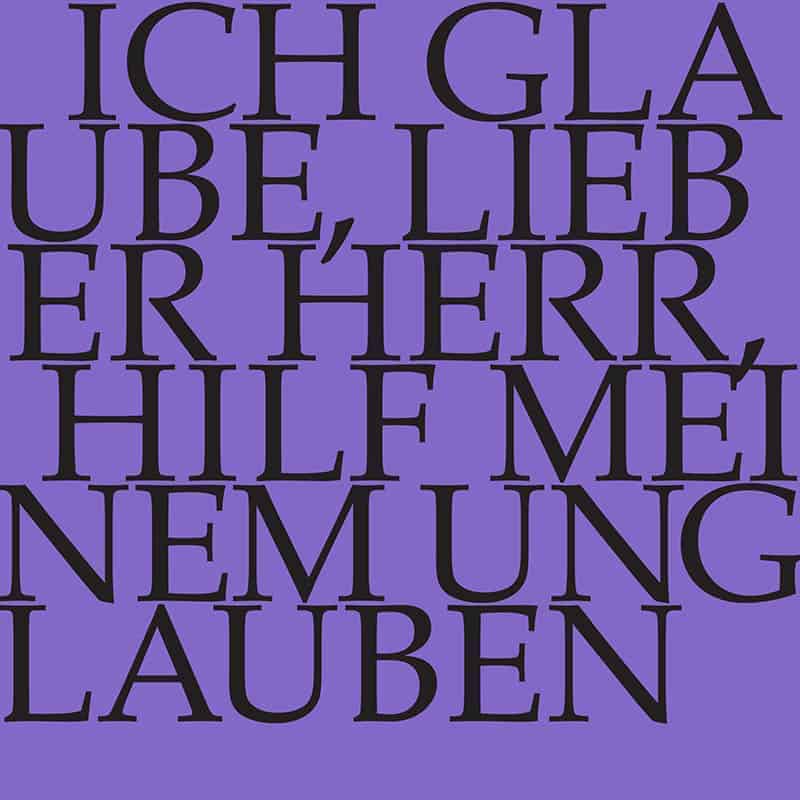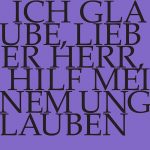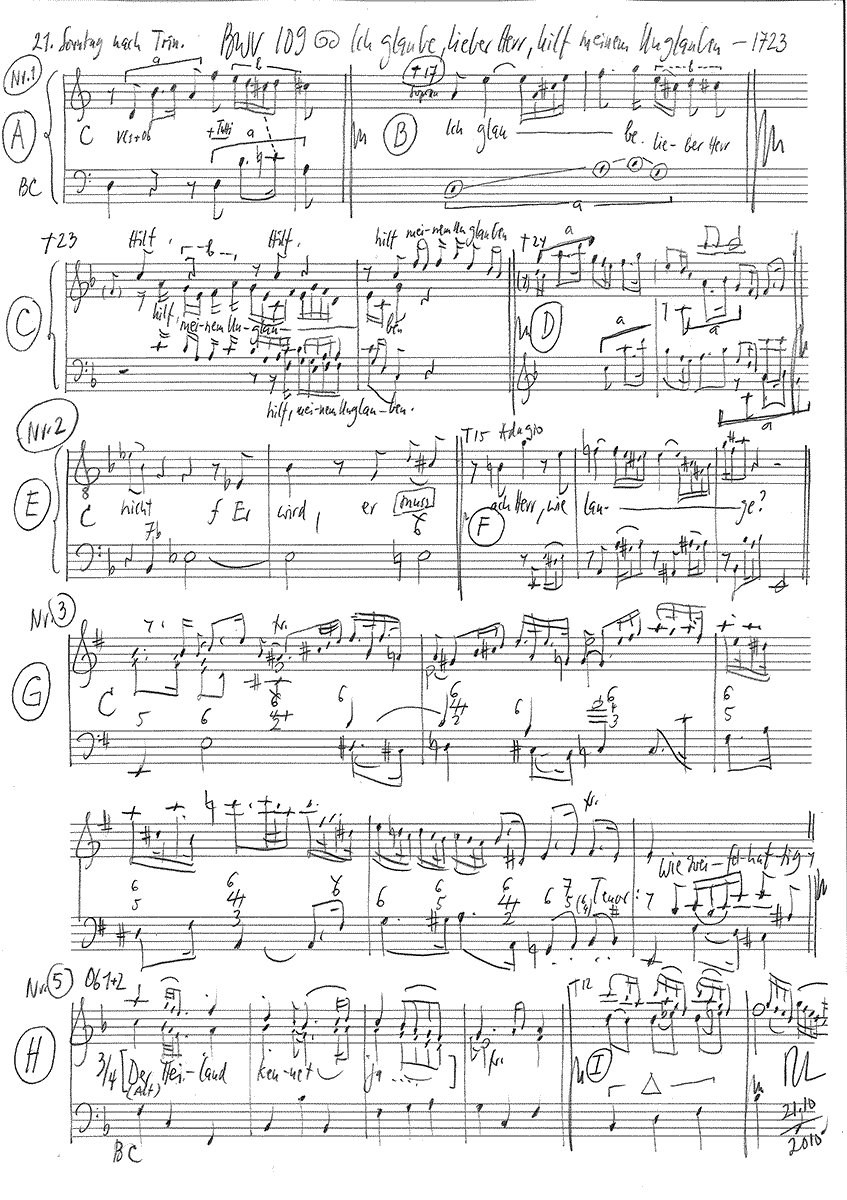
Ich glaube, lieber Herr, hilf meinem Unglauben
BWV 109 // For the Twenty-first Sunday after Trinity
(I have faith, O dear Lord, help my unbelieving) for alto and tenor, vocal ensemble, corno da caccia, oboe I+II, strings and continuo
The introductory chorus to cantata BWV 109, “Ich glaube, lieber Herr” (I have faith, O dear Lord) is one of Bach’s most memorable compositions on a Bible dictum.

Place of composition in the church year
Pericopes for Sunday
Pericopes are the biblical readings for each Sunday and feast day of the liturgical year, for which J. S. Bach composed cantatas. More information on pericopes. Further information on lectionaries.
Herr, lehre doch mich, dass es ein Ende mit mir haben muss und mein Leben ein Ziel hat und ich davon muss. Siehe, meine Tage sind einer Hand breit bei dir, und mein Leben ist wie nichts vor dir. Wie gar nichts sind alle Menschen, die doch so sicher leben! Sie gehen daher wie ein Schemen und machen sich viel vergebliche Unruhe; sie sammeln und wissen nicht, wer es einnehmen wird. Nun, Herr, wes soll ich mich trösten? Ich hoffe auf dich.
Zuletzt, meine Brüder, seid stark in dem Herrn und in der Macht seiner Stärke. Ziehet an den Harnisch Gottes, dass ihr bestehen könnet gegen die listigen Anläufe des Teufels. Denn wir haben nicht mit Fleisch und Blut zu kämpfen, sondern mit Fürsten und Gewaltigen, nämlich mit den Herren der Welt, die in der Finsternis dieser Welt herrschen, mit den bösen Geistern unter dem Himmel. Um deswillen ergreifet den Harnisch Gottes, auf dass ihr an dem bösen Tage Widerstand tun und alles wohl ausrichten und das Feld behalten möget. So stehet nun, umgürtet an euren Lenden mit Wahrheit und angezogen mit dem Panzer der Gerechtigkeit und an den Beinen gestiefelt, als fertig, zu treiben das Evangelium des Friedens. Vor allen Dingen aber ergreifet den Schild des Glaubens, mit welchem ihr auslöschen könnt alle feurigen Pfeile des Bösewichts; und nehmet den Helm des Heils und das Schwert des Geistes, welches ist das Wort Gottes.
Und es war ein Königischer, des Sohn lag krank zu Kapernaum. Dieser hörte, dass Jesus kam aus Judäa nach Galiläa, und ging hin zu ihm und bat ihn, dass er hinabkäme und hülfe seinem Sohn; denn er war todkrank. Und Jesus sprach zu ihm: «Wenn ihr nicht Zeichen und Wunder sehet, so glaubet ihr nicht.» Der Königische sprach zu ihm: «Herr, komm hinab, ehe denn mein Kind stirbt!» Jesus spricht zu ihm: «Gehe hin, dein Sohn lebt!» Der Mensch glaubte dem Wort, das Jesus zu ihm sagte, und ging hin. Und indem er hinabging, begegneten ihm seine Knechte, verkündigten ihm und sprachen: «Dein Kind lebt!» Da forschte er von ihnen die Stunde, in welcher es besser mit ihm geworden war. Und sie sprachen zu ihm: «Gestern um die siebente Stunde verliess ihn das Fieber.» Da merkte der Vater, dass es um die Stunde wäre, in welcher Jesus zu ihm gesagt hatte: «Dein Sohn lebt.» Und er glaubte mit seinem ganzen Hause. Das ist nun das andere Zeichen, das Jesus tat, da er aus Judäa nach Galiläa kam.
Would you like to enjoy our videos ad-free? Subscribe to YouTube Premium now...
Workshop
Reflective lecture
Publikationen zum Werk im Shop
Choir
Soprano
Susanne Frei, Guro Hjemli, Noëmi Tran Rediger
Alto
Jan Börner, Antonia Frey, Olivia Heiniger, Katharina Jud, Lea Scherer
Tenor
Clemens Flämig, Nicolas Savoy, Walter Siegel
Bass
Fabrice Hayoz, Valentin Parli, William Wood
Orchestra
Conductor
Rudolf Lutz
Violin
Michi Gaigg (special Guest), Renate Steinmann, Plamena Nikitassova, Anaïs Chen, Sylvia Gmür, Martin Korrodi, Olivia Schenkel
Viola
Susanna Hefti, Emmanuel Carron
Violoncello
Martin Zeller
Violone
Iris Finkbeiner
Oboe
Kerstin Kramp, Andreas Helm
Bassoon
Susann Landert
Corno da caccia
Olivier Picon
Organ
Norbert Zeilberger
Harpsichord
Oren Kirschenbaum
Musical director & conductor
Rudolf Lutz
Workshop
Participants
Karl Graf, Rudolf Lutz
Reflective lecture
Speaker
Suzette Sandoz
Recording & editing
Recording date
10/22/2010
Recording location
Trogen
Sound engineer
Stefan Ritzenthaler
Director
Meinrad Keel
Production manager
Johannes Widmer
Production
GALLUS MEDIA AG, Switzerland
Producer
J.S. Bach Foundation of St. Gallen, Switzerland
Librettist
Text No. 1
Quote from Mark 9:24
Text No. 2–5
Poet unknown
Text No. 6
Lazarus Spengler, 1524
First performance
Twenty-first Sunday after Trinity,
17 October 1723
In-depth analysis
The introductory chorus to cantata BWV 109, “Ich glaube, lieber Herr” (I have faith, O dear Lord) is one of Bach’s most memorable compositions on a Bible dictum. Featuring a patiently unfolding ritornello and persistent circling of the brief Bible verse, the setting demonstrates Bach’s efforts in the first year of his Leipzig tenure to elevate the formal and text-interpretive quality of church music in the city. In this movement, the textual tension between a resolute struggle for faith and the resigned acceptance of personal weakness is captured in music that unites a distinctive ascending head motive with a plaintive tone. Here, the undulating motion and shifting timbres convey the impression of a tussle with faith similar to the discussions on the road to Emmaus. Accordingly, the gestures of the individual parts, voice pairings, and instruments are alternated with energetic choral insertions; the exalted cries of “Help!” and dense scoring lend the plea for faith an urgent sincerity that is fortified by a corno da caccia, which Bach later added to underscore important tonal dimensions.
The discrepancy between confidence and doubt is retained in the tenor recitative, but re-cast as a highly conflicted inner-dialogue on the part of the soloist. Here, doctrinal statements are proclaimed in a forte, sermon-like style only to be followed by restrained passages of anxiety that the Highest, despite his promise to all Christendom, might refuse to hear individual sinners in their hour of need. This music proffers little in the way of consolation and assurance: rather, the closing adagio passage embodies the exhaustion after the trials of the cross, a teetering on the verge of resignation.
This gesture is then sustained in an aria whose distinct Passion-like tone calls to mind the sombre, despairing arias of Peter. Trapped in a dense E minor string setting, the tenor voice desperately seeks refuge amid chromatically descending lines and whipping violin figures that evoke the convulsive hellish flames already burning in the human heart. In the middle section, the “wavering” of the solo part morphs into burdensome sounds of pain: in this aria full of tragic passion, Bach makes it clear that despite every effort, the longed-for surety of faith cannot be wrought from sheer will alone – a central tenet of Lutheran theology that is rendered tangible in a daring, opera-like setting.
Following this musical crisis of faith, the alto recitative presents the sudden reversal of fate: Jesus, in accordance with a bold theological paradox, is not found only in the word of the gospels but even today “still doth wonders work”. As such, redemption is closer at hand than thought – if the “eyes of faith” are open and ready to embrace God’s promise.
The ensuing aria reveals the power this message has to console precisely through its eschewal of expressive extravagance: the minuet-style movement of consonant oboes with continuo accompaniment, much like a children’s song, musically captures the desired attitude of humble trust. When the duo of oboes overpowers the alto soloist (often singing in a low register), the impression arises that, in the face of dwindling hope, the instruments are taking up the word for the speechless human voice. In such arias, Bach unites his usual compositional prowess with a refined instinct for textual nuance and genuine human concerns.
Surprisingly, this contemplative moment of devotion is not followed by a simple setting in four-part harmony, but instead by a dramatic closing chorale. Here, the sopranoled choir presents a hammering rendition of the hymn, driven by a stormy orchestral concerto replete with abrupt ascending gestures and cutting long chords. In this movement, Bach not only re-visits the expansive ensemble music of the introductory chorus in accelerated form: the apotheosis of victorious trust in God, equally embodied in text and music, also answers the helpless plea for faith expressed in the opening dictum. The effect is that of a moving self-empowerment of church music: it is the early Protestant congregational chorale that fosters unity and fortifies the wavering strength of the individual members in a nigh unrestrained fashion. In this setting, it is audibly clear that Bach was already testing the waters for his great chorale cantata project of 1724/25.
Libretto
1. Chor
«Ich glaube, lieber Herr, hilf meinem Unglauben!»
2. Rezitativ (Tenor)
Des Herren Hand ist ja noch nicht verkürzt;
mir kann geholfen werden.
Ach nein! Ich sinke schon zur Erden
vor Sorge, daß sie mich zu Boden stürzt.
Der Höchste will, sein Vaterherze bricht.
Ach nein! Er hört die Sünder nicht.
Er wird, er muß dir bald zu helfen eilen,
um deine Not zu heilen.
Ach nein! Es bleibet mir um Trost sehr bange,
ach Herr, wie lange?
3. Arie (Tenor)
Wie zweifelhaftig ist mein Hoffen,
wie wanket mein geängstigt Herz!
Des Glaubens Docht glimmt kaum hervor,
es bricht dies fast zustoßne Rohr,
die Furcht macht stetig neuen Schmerz.
4. Rezitativ (Alt)
O fasse dich, du zweifelhafter Mut,
weil Jesus itzt noch Wunder tut!
Die Glaubensaugen werden schauen
das Heil des Herrn;
scheint die Erfüllung allzu fern,
so kannst du doch auf die Verheißung bauen.
5. Arie (Alt)
Der Heiland kennet ja die Seinen,
wenn ihre Hoffnung hülflos liegt.
Wenn Fleisch und Geist in ihnen streiten,
so steht er ihnen selbst zur Seiten,
damit zuletzt der Glaube siegt.
6. Choral
Wer hofft in Gott und dem vertraut,
der wird nimmer zu Schanden;
denn wer auf diesen Felsen baut,
ob ihm gleich geht zu Handen
viel Unfalls hie, hab ich doch nie
den Menschen sehen fallen,
der sich verläßt auf Gottes Trost;
er hilft sein’ Gläubgen allen.









